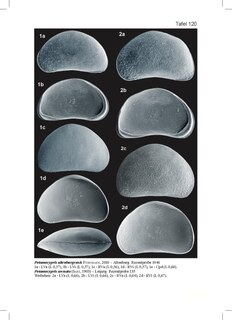Related Research Articles

Ostracods, or ostracodes, are a class of the Crustacea, sometimes known as seed shrimp. Some 70,000 species have been identified, grouped into several orders. They are small crustaceans, typically around 1 mm (0.039 in) in size, but varying from 0.2 to 30 mm in the case of Gigantocypris. Their bodies are flattened from side to side and protected by a bivalve-like, chitinous or calcareous valve or "shell". The hinge of the two valves is in the upper (dorsal) region of the body. Ostracods are grouped together based on gross morphology. While early work indicated the group may not be monophyletic; and early molecular phylogeny was ambiguous on this front, recent combined analyses of molecular and morphological data found support for monophyly in analyses with broadest taxon sampling.
Kapcypridopsis is a genus of ostracod crustaceans in the family Cyprididae, subfamily Cypridopsinae. It includes the critically endangered species Kapcypridopsis barnardi.
Limnocythere is a genus of ostracod crustaceans in the family Limnocytheridae. It contains the following extant species :
Liocypris grandis is a species of ostracod which was long presumed extinct. It was rediscovered in the Western Cape of South Africa in 2003, having not been seen since its original description by Georg Ossian Sars in 1924. It was assessed as extinct for the IUCN Red List in 1996, and that assessment has not been updated.

Gigantocypris is a genus of ostracod crustaceans in family Cypridinidae, and among the most well-known members of the class Ostracoda. Its members are extremely large for ostracods, measuring up to 3.2 cm (1.3 in) across, have a globular shape, are typically semi-transparent orange or reddish, and have relatively large mirror-like eyes that are used to locate their small animal prey. They are found worldwide in dark, deep and cold oceans.
Typhlocypris is a genus of ostracods, which are a class of small, bivalved crustaceans. It includes Pseudocandona, formerly recognised as a separate genus, as one of its two constituent subgenera. The nominate subgenus is divided into four species groups: the eremita species group, the caribbeana species group, the rostrata species group, and the prespica species group.

Cyprididae is "the most diverse group of freshwater ostracods". It contains 1000 species, which represents 50% of the known species of freshwater ostracods. Around 60% of genera in the family are endemic to a single zoogeographic region. The family contains 25 subfamilies, and is most diverse in the Afrotropical realm, with over 300 species in 45 genera. Many Cyprididae occur in temporary water bodies and have drought-resistant eggs, mixed/parthenogenetic reproduction and ability to swim. These biological attributes pre-adapt them to form successful radiations in these habitats. Bennelongia is an interesting genus of the family Cyprididae. It may be the last true descendant genus of the Mesozoic lineage of Cypridea, which was a dominant lineage of ostracod in non-marine waters in the Cretaceous.
Candonidae is a family of ostracods, containing around 25% of all known species of freshwater ostracods. Around 75% of genera in the family are endemic to a single zoogeographic region. It contains more than 500 species, of which more than 300 are endemic to the Palearctic realm.
Bennelongia is a genus of ostracod crustaceans in the family Cyprididae. It is probably endemic to Australia and New Zealand, and is predicted to be highly diverse. The genus was described in 1981 and named after Woollarawarre Bennelong, the first aboriginal to have a long association with the early European settlers of Australia. Prior to 2012, six species were described in Australia. There are currently 15 species of Bennelongia. Bennelongia may be the last true descendent genus of the Mesozoic lineage of Cypridea, which was a dominant lineage of ostracod in non-marine waters in the Cretaceous.
Potamocypris is a genus of ostracod crustaceans in the family Cyprididae. There are currently 44 extant species of Potamocypris. The majority of the species occur in freshwater habitats; only a few species of the genus colonize marine brackish coastal waters.
Potamocypris unicaudata is a species of ostracod crustacean in the family Cyprididae, subfamily Cypridopsinae. It is abundantly found in ditches and ponds near the sea shore, where freshwater slightly mingles with sea water. It is known from both Europe and North America.
Potamocypris smaragdina is a species of ostracod crustacean in the family Cyprididae, subfamily Cypridopsinae. It is known from both Europe and North America.

Potamocypris arcuata is a species of ostracod crustacean in the family Cyprididae, subfamily Cypridopsinae. It is mainly known from the southern areas of the Palaearctic.

Christian Gustav Wilhelm Müller was a German zoologist specializing in Ostracoda.
This list of fossil arthropods described in 2015 is a list of new taxa of trilobites, fossil insects, crustaceans, arachnids and other fossil arthropods of every kind that have been described during the year 2015. The list only includes taxa at the level of genus or species.
Conchoecia is a genus of ostracods in the subfamily Conchoecinae.
Cypricercus elegans is a species of freshwater ostracod in the family Cyprididae. It is found in Colombia.
Chlamydotheca elegans is a species of freshwater ostracods in the family Cyprididae. It is found in Colombia.
This list of fossil arthropods described in 2018 is a list of new taxa of trilobites, fossil insects, crustaceans, arachnids and other fossil arthropods of every kind that were described during the year 2018, as well as other significant discoveries and events related to arthropod paleontology that are scheduled to occur in the year 2018.
References
- ↑ Mémoire sur divers Crustacés nouveaux du Mexique et des Antilles. H Saussure, 1858
- ↑ "The genus Chlamydotheca Saussure (Crustacea: Ostracoda) in northeastern Argentina" (PDF). Nauplius Journal. Retrieved 3 April 2018.
- ↑ E Roessler, 1986, Caldasia, 14, (68-70), pages 617-650
- ↑ Pierce, Harold G. (1988). "Chlamydotheca llanoensis n. sp.: a large ostracode from the latest Pleistocene of the Southern High plains, useful in correlation of streamside Paleo-Indian sites". Journal of Paleontology. 62 (3): 445–447. doi:10.1017/S0022336000059230.